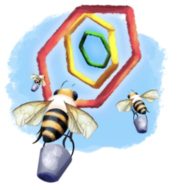3 Steps to “Bake Your Idea”

To turn your early idea into something truly delicious, try our three-step process to “bake your idea.” This process is recommended for workshops, or turning your own good idea into a truly great one.
- Step 1: Pick a genre and “hook.” Information alone is rarely enough. Is yours detective noir? Or perhaps painfully punny? Are you personifying something truly unusual — and with what tone? Push the limits of style and be conversational wherever possible.
- Step 2: Next, imagine it WITHOUT technology (and alternative forms). We always recommend using the simplest system possible. This thought exercise also helps to rapidly identify the form of your activity to ensure it will resonate with real residents. Then when you add in more technology, you will be more likely to play to the strengths of both Hive Mechanic and the cultural assumptions of your audience for your chosen format.
- Step 3: Sprinkle with Playfulness. Even if you’re not making a game, you want engagement. We show how to borrow from the science of game design thinking to bring people together and into public space.
How to imagine a version WITHOUT technology…
Considering a “non-digital” version of your activity is useful for accessibility AND to identify underlying “genres” of your activity to ease the onramp to participation. For example, consider: what if you simply did a tour led by a local resident with printed historic photographs to pass around? Think about what makes such tours great, and why you’d do a partly digital one. Identifying a specific goal can help ensure you are maximizing that element throughout your design of narrative and mechanics. A few more non-digital alternatives to consider: a scavenger hunt with a paper checklist; or a printed book about “what would this mural say, if it came to life?” For any analog activity, think about where the human is providing most value. For example, tour guides often layer their own specific story and stakes into the otherwise-neutral history; so unless your digital version does that too, it will probably be even drier and less personal than a traditional tour.
Alternative technologies?
Can you use a single technology or simpler system? You’ll make better use of Hive Mechanic if you know how it is distinctly useful. Consider:
- Podcast or audio files for “listening in place.” Such audio can be organized with QR codes or a simple postcard with a map and instructions.
- AR (augmented reality) app. These can be flashy and so much fun. They also tend to require smartphones with data plans, which are less accessible and equitable than text and multimedia messaging for some populations. Many allow you to set up GPS “fences” to trigger when you are nearby, which is a clear plus. For casual public events and engagement, we find that most people refuse to download an app — but will text or call a number.
- Twilio Studio for SMS and Branching Audio. We use Twilio as our hidden infrastructure for our texting, MMS and voice calling. They provide a very pretty graphical interface for making decision trees that can work for some of the examples we recommend. But even with “no coding,” the interface and approach often assume intermediate or advanced technical thinking and a willingness to put in a credit card early on. Many of the intermediate features of Hive Mechanic can only be done on Twilio if you have basic knowledge of computer science.
- Scavenger hunt tools, including apps with printable QR codes. These can be wonderful, but they also can be difficult to use for storytelling and often charge. They can be difficult or even impossible to connect to smart city data streams, Raspberry Pi installations, etc.
Analog playfulness and game design thinking?
- Icebreakers. So obvious, and yet so often omitted in digital creations. Social play is a powerful force to create the space to meet neighbors or try out content that would otherwise be for “other people.” These can be incorporated into Hive Mechanic experiences.
- Street theater and improvisation. Humor similarly can open eyes and create room, including with satire or even simple puns. These can be incorporated into Hive Mechanic too!
- Public spectacle, such as races and events.
- More to be added soon…
